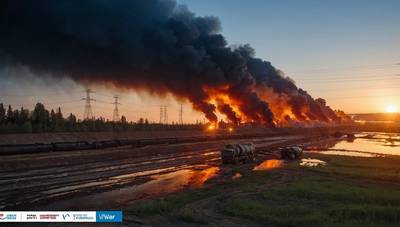Russian energy exports disrupted since the start of Ukraine War
One of the bargaining chips that Donald Trump will use to convince Vladimir Putin to progress towards a ceasefire agreement in Ukraine when he meets him on Friday is to reduce U.S. restrictions on Russia's exports and energy industry.
Trump has also warned of tougher sanctions in the event that there is not progress.
See how the sanctions have affected Russian energy exports.
Natural Gas and LNG
Before the war, Russia was Europe's largest natural gas supplier. The majority of gas was transported via four pipeline routes, including Nord Stream, which runs under the Baltic Sea; the Yamal Line, which crosses Poland; transit via Ukraine and Turkstream.
Europe imports Russian LNG as well.
According to the European Commission, in 2021, the total Russian gas imported into the EU amounted to 150 billion cubic meters (bcm) a year. This was 45% of the total imports. Since then, the total has dropped to 52 bcm, or 19%.
The EU hasn't imposed sanctions against Russian gas imports via pipelines. However, contract disputes, and the damage caused to Nord Stream by an explosion have led to a reduction in supplies.
In a new round of sanctions announced by the European Union in July, all transactions involving goods and services related to Nord Stream have been banned.
The transit via Ukraine will end at the end 2024. This leaves only Turkstream as an operational route for Russian gas pipelines to Europe.
The European Commission also proposed an legally binding ban by the end 2027 on EU imports from Russia of gas and LNG, but it hasn't been enacted into law yet.
In 2024, the U.S. imposed sanctions against companies that supported the Arctic LNG 2 Project in Russia. This project would have become Russia's biggest plant, with a final output of 19,8 million metric tonnes per year.
During the first year of war in Ukraine, the U.S. and UK banned the importation of crude oil and refined petroleum from Russia.
The G7 group (including the US and UK) has imposed an embargo on Russian crude oil shipped to third countries, with a $60 barrel price limit in December 2022. Fuels will be subject to a similar cap the following month.
The EU and UK
ективн
The crude price cap in June 2025 will be $47.60 or 15% less than the average market price. However, the U.S. has not supported the move.
The cap is designed to reduce Russia's revenue from oil sales. It prohibits shipping, insurance and Reinsurance companies from handling tanks carrying crude that trades above the cap.
Western powers also sanctioned more than 440 tanks belonging to the so called
Shadow Fleet
Transports oil sanctioned outside the Western services and price cap. Sovcomflot, the largest Russian shipper, is also subject to sanctions in Western countries.
The U.S. also sanctions major corporations
Russian oil companies
Gazprom Neft, Surgutneftegaz and others are included.
Russian oil has been redirected towards Asia by the measures that have restricted Russian oil trade in the west, as well as banned Russian oil imports. China, India and Turkey are now the main buyers of Russian crude.
The price cap was intended to keep Russian oil flowing, preventing a spike in oil prices worldwide that would have resulted from a stoppage or a severe drop in Russian imports.
Trump, however, has signalled a shift in policy by threatening secondary sanctions against India and China if they continue to buy Russian oil in order to pressure Putin into agreeing to a ceasefire.
Eurostat data shows that the European Union will ban imports of Russian coal by 2022. Volumes are expected to drop from 50 millions metric tons in 2021 to zero in 2023.
(source: Reuters)





